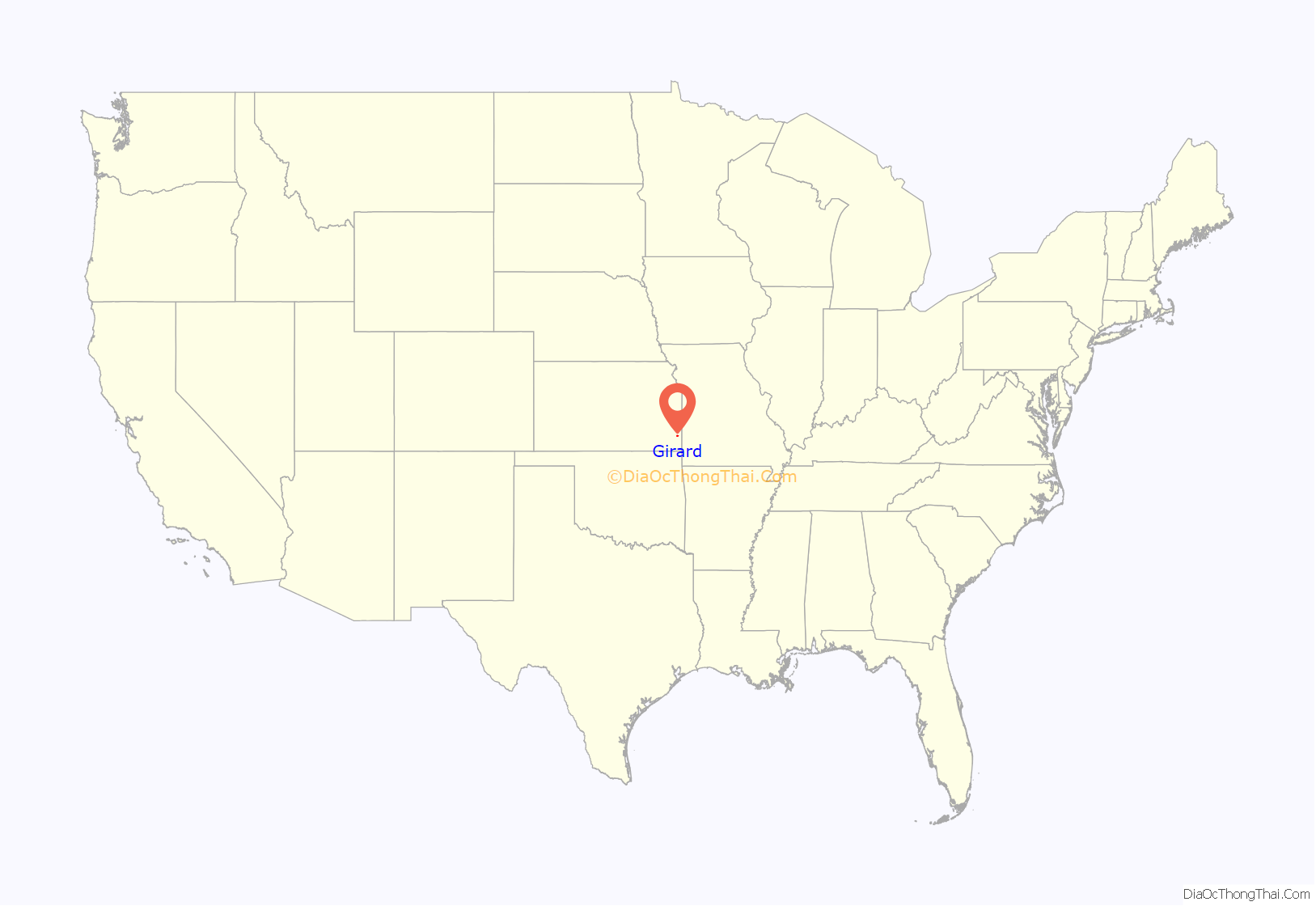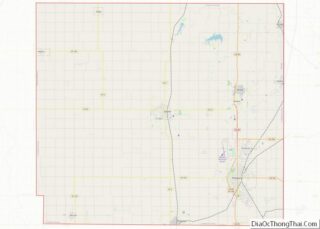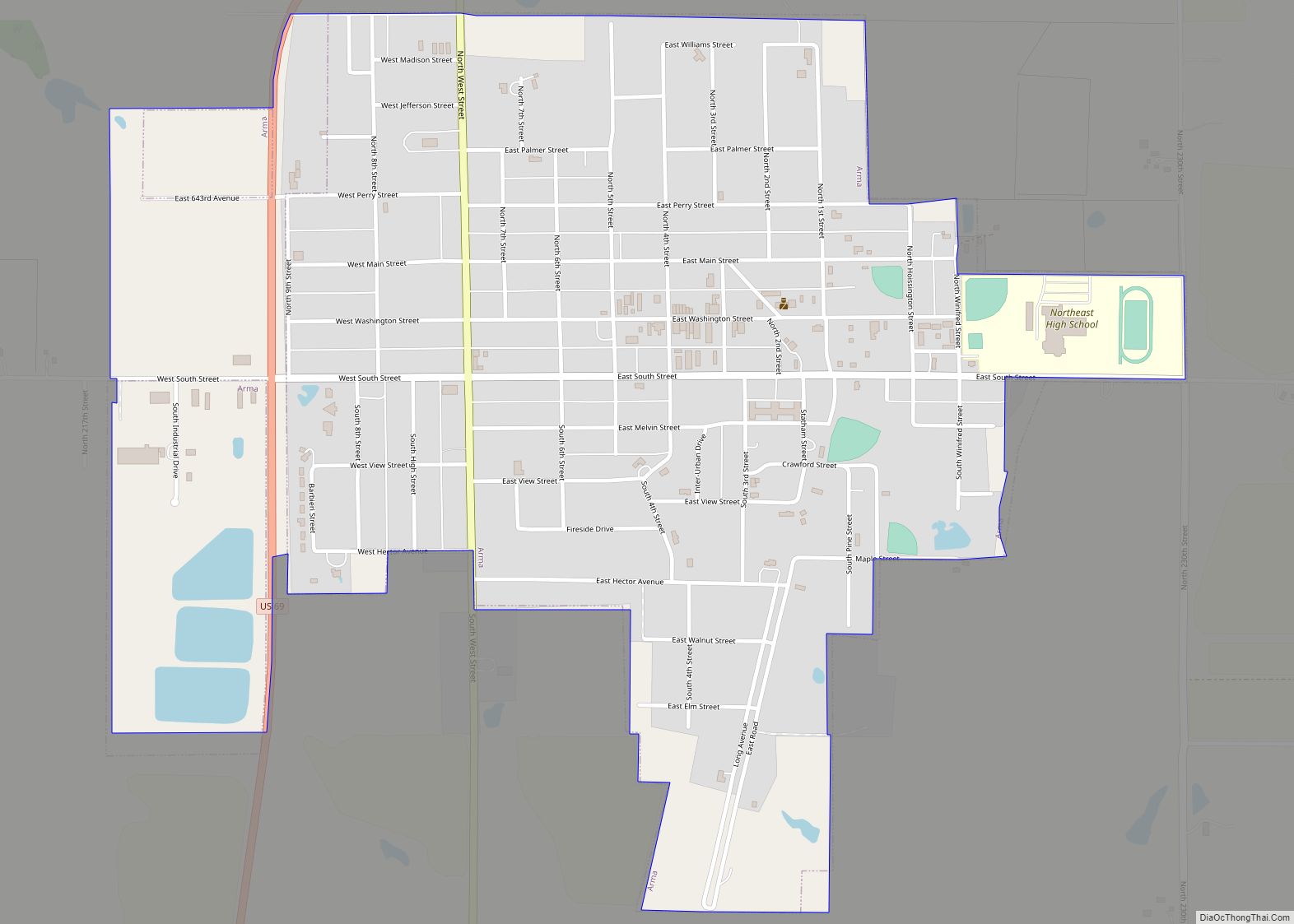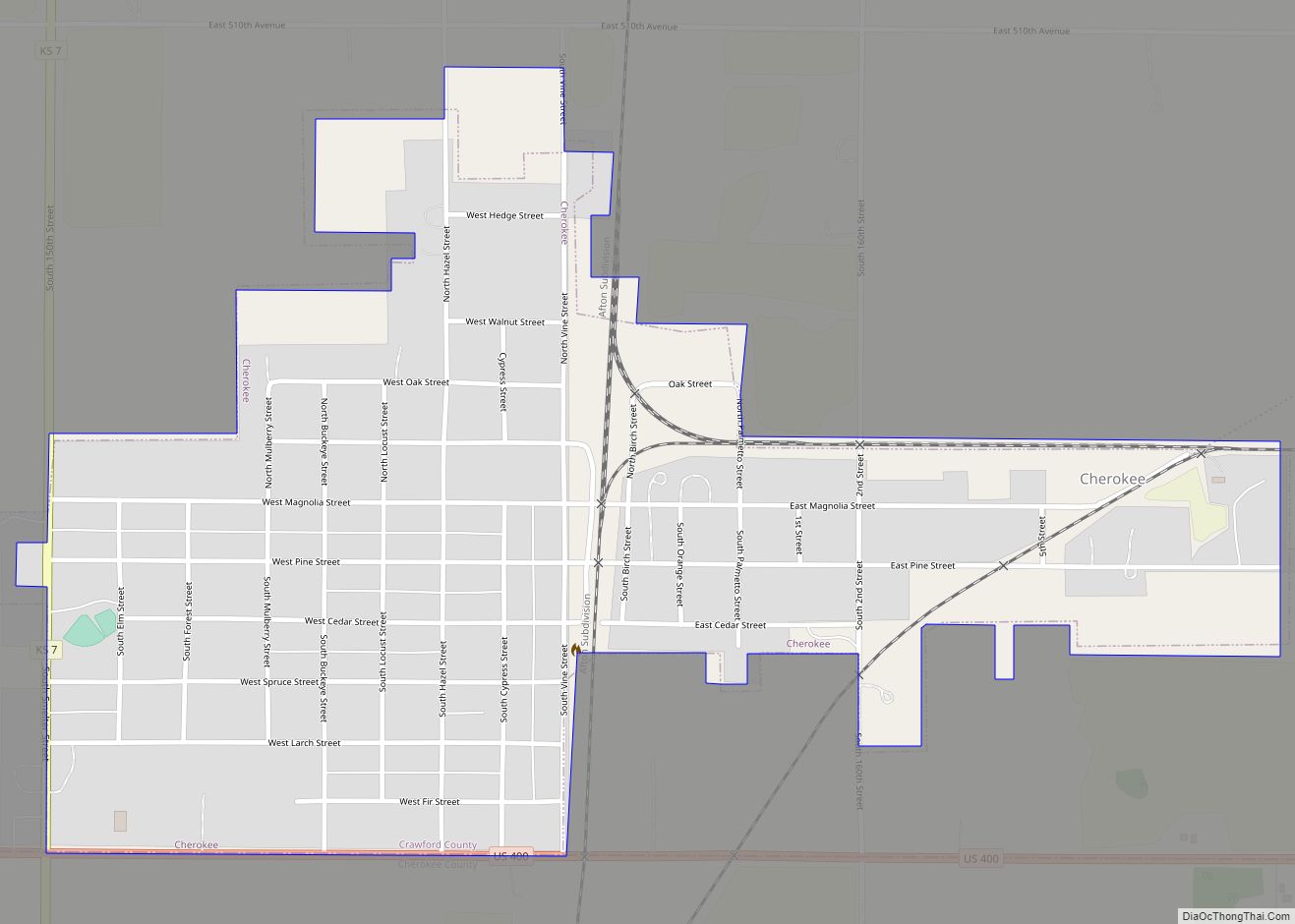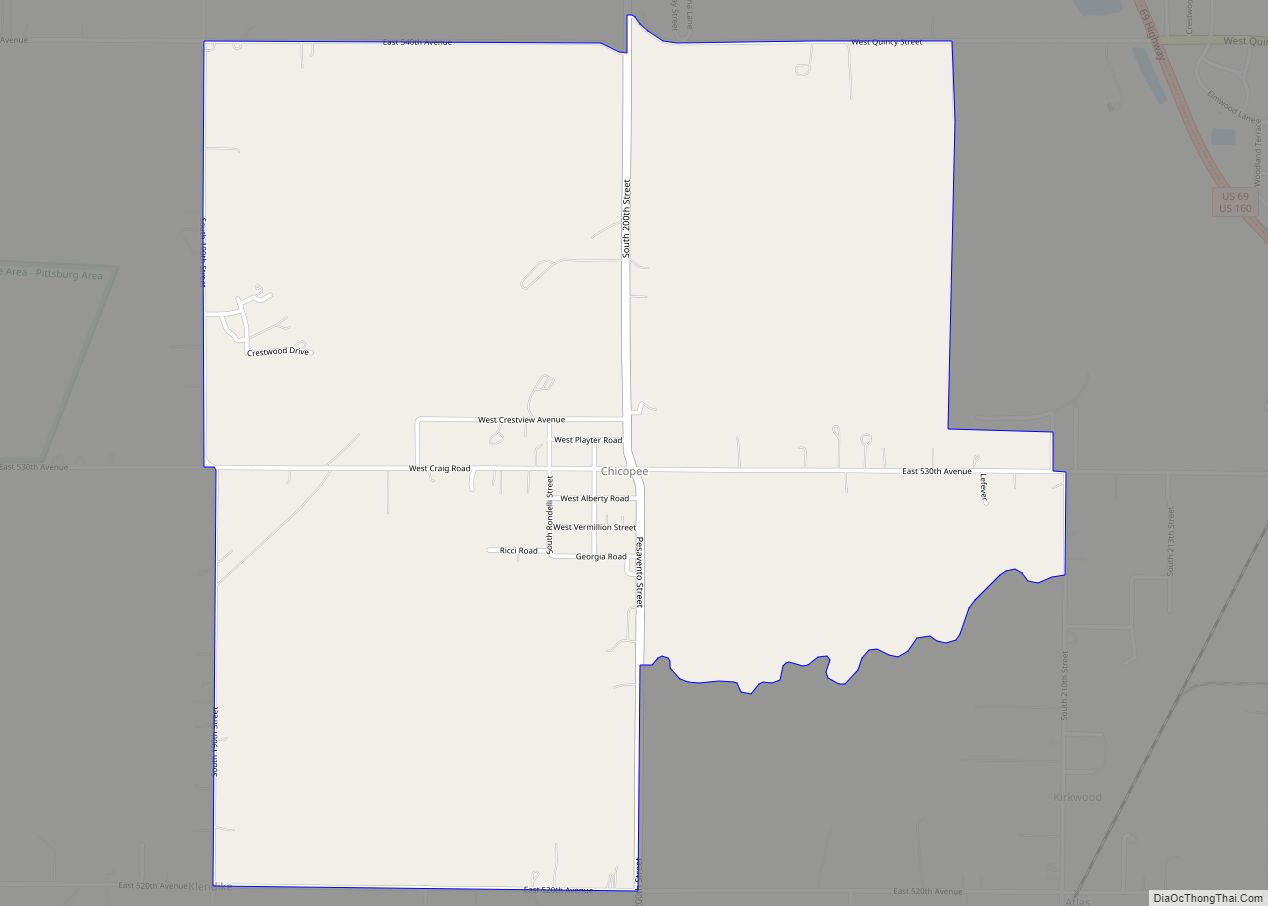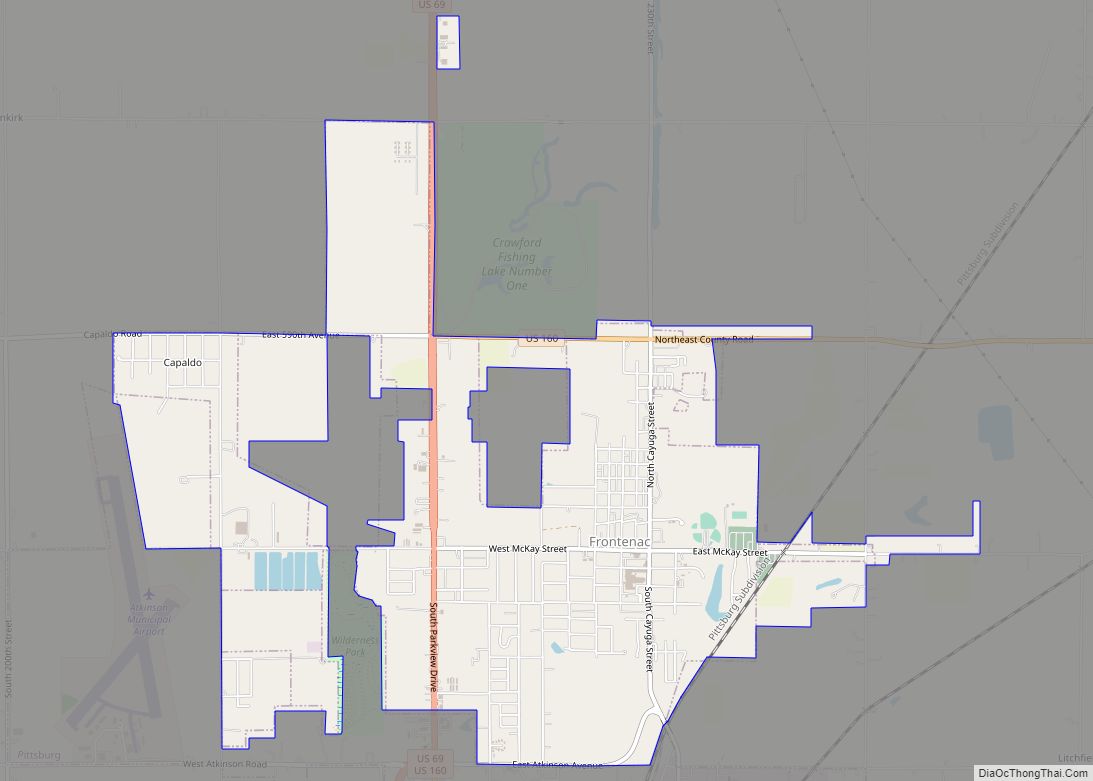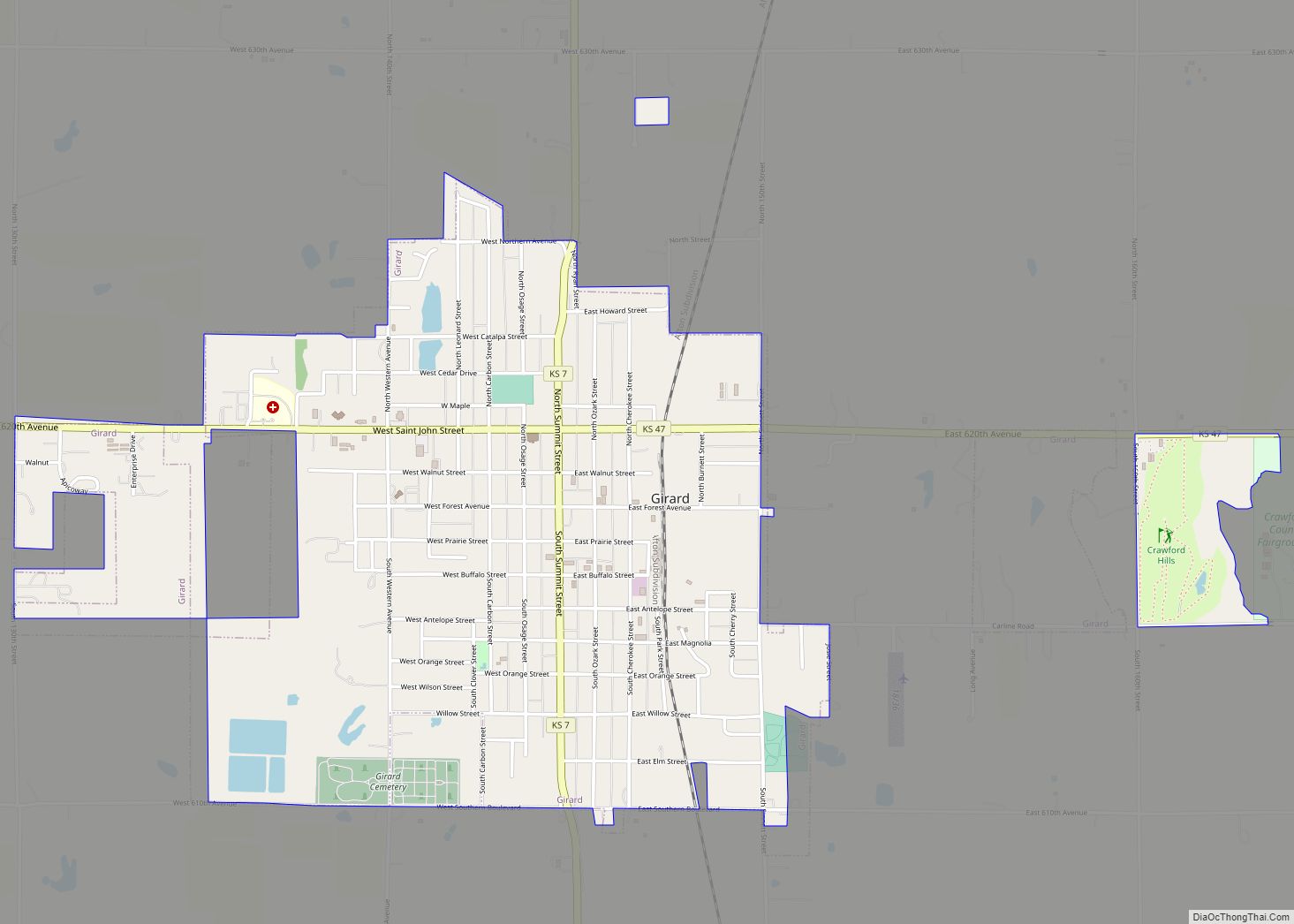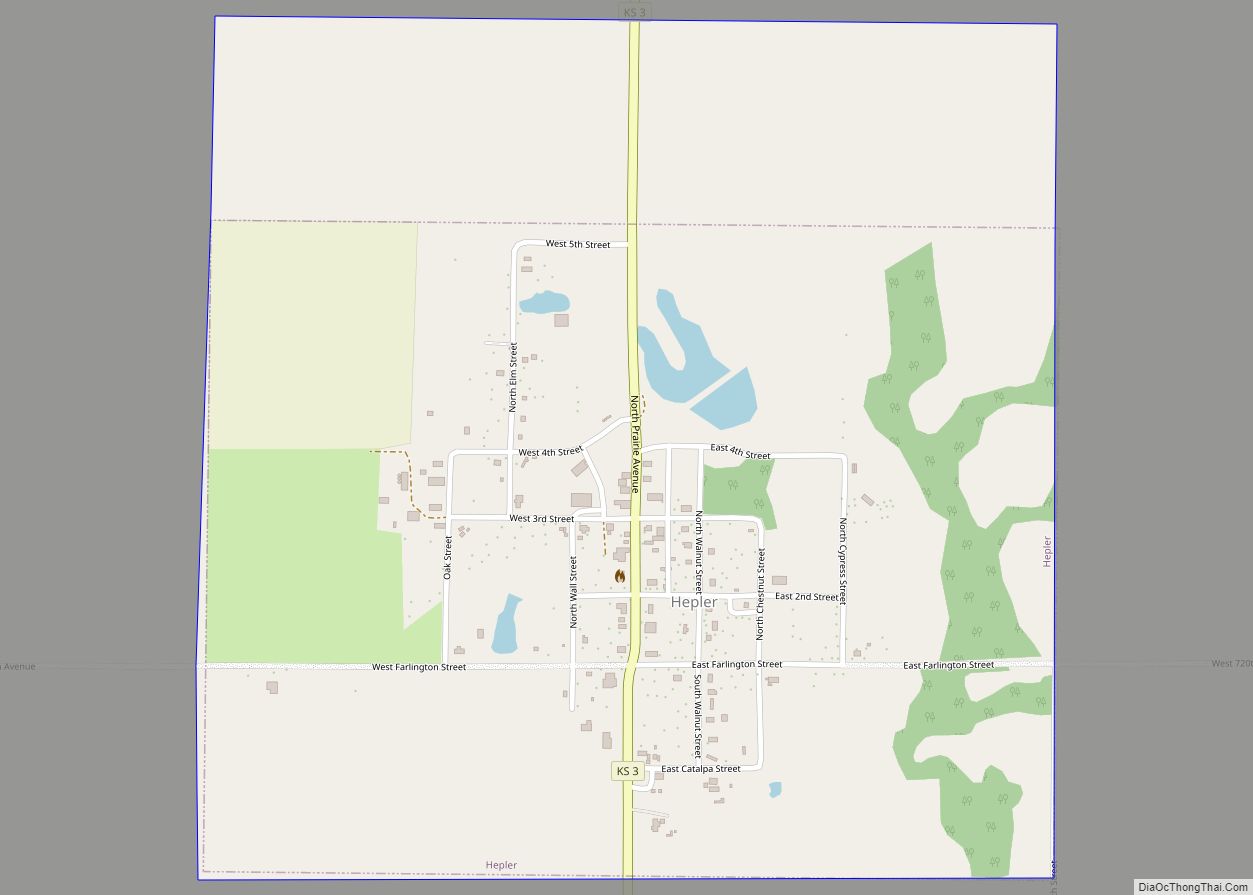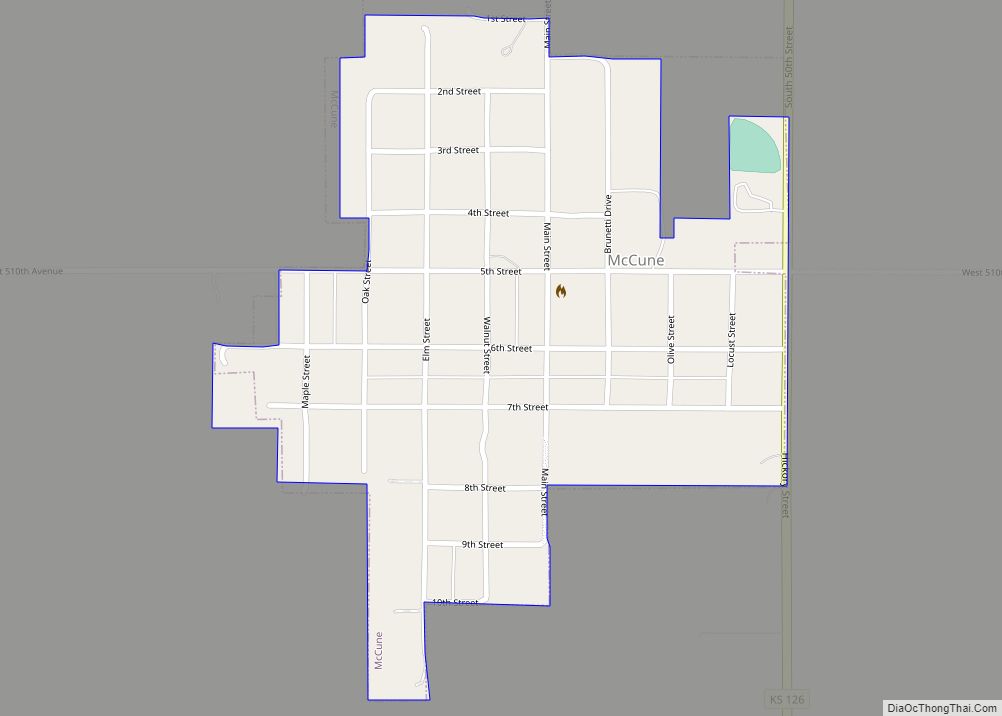Girard is a city in and the county seat of Crawford County, Kansas, United States. As of the 2020 census, the population of the city was 2,496.
| Name: | Girard city |
|---|---|
| LSAD Code: | 25 |
| LSAD Description: | city (suffix) |
| State: | Kansas |
| County: | Crawford County |
| Founded: | 1868 |
| Incorporated: | 1869 |
| Elevation: | 984 ft (300 m) |
| Total Area: | 2.37 sq mi (6.14 km²) |
| Land Area: | 2.33 sq mi (6.05 km²) |
| Water Area: | 0.04 sq mi (0.10 km²) |
| Total Population: | 2,496 |
| Population Density: | 1,100/sq mi (410/km²) |
| ZIP code: | 66743 |
| Area code: | 620 |
| FIPS code: | 2026300 |
| Website: | girardkansas.gov |
Online Interactive Map
Click on ![]() to view map in "full screen" mode.
to view map in "full screen" mode.
Girard location map. Where is Girard city?
History
Girard was founded in the spring of 1868, in opposition to Crawfordsville, and named after the town of Girard, Pennsylvania, the former home of trustee Charles Strong. It was based around the surveyed line of the Kansas City, Fort Scott and Gulf Railroad, in an attempt to gain an advantage over its rival.
The first post office in Girard was established in September 1868.
The first celebration in Girard occurred on July 4, 1868, marking Sunday school and Independence Day. Under a law passed in March 1871, Girard became a city of the third class. In early April the first city officers were elected. The last meeting of the trustees was held April 5, and the first meeting of the new Council was held on April 7.
Franklin Playter started the first bank in Girard in June, 1871. In 1872, he erected for the accommodation of his business a two-story brick building, the first brick building in the city. In June, 1879, this bank was succeeded by the Bank of Girard, established by E. R. Moffit. The Bank of Girard was succeeded in 1882 by the Girard Bank.
The Girard Mills were built in 1870, and began operations in the spring of 1871. The first building was a 2+1⁄2-story frame, costing, with the machinery and power, $10,000. The property was owned by Tontz & Hitz. In 1879, Tontz retired from active participation in the management of the business, In 1882 he sold his interest to Hitz, who erected a 3+1⁄2-story brick mill, put in five run of buhrs, and two sets of Gray’s patent rollers, making it a combined mill.
The Crawford County Mills were built in 1870 by a stock company. These mills are two and a half stories high, contain three run of buhrs and one set of rollers, thus being also a combined mill, and the machinery is propelled by a twenty-five horse-power engine.
Carbon Creek was the location of the first mining camp of the county. No shafts were sunk at first, but several strip pits were opened. From the strip pits, slopes were run along the veins, and coal operations opened on a small scale. By 1877 perhaps one hundred miners were working along Carbon Creek, getting out coal.
In the 1960s many of the mines closed. Today the landscape of southeastern Crawford County is covered with long strip mines now full of water and serving as fishing lakes & unfarmed wildlife habitat. The ruins of abandoned zinc and lead smelters can also be seen; many are Superfund sites polluted with the toxic remains of smelter operations. The economy that was driven by industrialized mining and smelting during the first half of the 20th century in the early 21st century is dominated by agriculture.
The Girard Public Library has several record books and other resources pertaining to mining operations in Southeast Kansas.
With the growth of the mining industry in Crawford County, large numbers of immigrants from Southern Europe and the Balkans were brought in to work in the mines. These immigrants were more often adherents of Catholicism in contrast to the generally Protestant population previously in the county. At the time this created social tension but today Crawford county celebrates its South European heritage with the annual “Little Balkan Days” event.
To dig the coal, the city began a concentrated effort to attract coal miners from other areas of the United States and from the coal-producing nations of Europe. Overseas, broadsides were distributed along the Mediterranean, promising prosperity in the coal fields of southeast Kansas. Steamship companies sent agents throughout Europe to recruit workers, underwriting one-way passage. From 1880 through 1915, huge waves of immigrants came to southeast Kansas. In all, over fifty nationalities came to mine coal and work in the area’s smelters and other industries.
In the first decades of the 20th century, Girard became a hub of socialist politics. Populist Percy Daniels, whose farm was nearby in Crawford Township, briefly owned the Girard Herald and used it to promote his views; he was elected lieutenant governor in 1892. In 1896, Julius Wayland moved to Girard from Kansas City, Missouri and brought with him his socialist periodical Appeal to Reason. In 1900 he employed Fred Warren as his co-editor. Warren was a well-known figure on the left and managed to persuade some of America’s leading progressives to contribute to the Appeal to Reason.
In 1904, Warren commissioned Upton Sinclair to write a novel about immigrant workers in the Chicago meat-packing houses. Wayland provided Sinclair with a $500 advance and after seven weeks’ research, he wrote the novel, The Jungle. Serialized in 1905, the book helped to increase circulation of the newspaper to 175,000. After the book was published by Doubleday in 1906, the popularity of the Appeal to Reason increased, as did the attacks on Wayland and Warren. The phenomenal success of Wayland’s newspaper meant that he developed a printing plant capable of handling a weekly newspaper of huge circulation; on occasion more than 400,000 copies per week were printed. The Appeal to Reason Company issued hundreds of other socialist publications in addition to the Appeal, making the Girard, Kansas name known.
During the decade of the 1900s, Eugene V. Debs lived in Girard and worked on the Appeal. He was the Social Democratic Party candidate for President of the United States in the election of 1900. He ran for President again on the Socialist Party of America ticket in 1904, 1908, and 1912. Debs received 901,000 votes in the election of 1912 (6% of the vote). In 1908, he kicked off his campaign for president from the steps of the Crawford County courthouse in Girard. In 1912 he carried Crawford County (one of four counties he carried nationwide).
During World War I, Debs was a subject of efforts by President Wilson to suppress dissent against the war. He was convicted of violating the Smith Espionage Act and, in September 1918, was sentenced to 10 years in prison. In 1920 he ran for President while still incarcerated in the Atlanta Penitentiary. He received 919,799 votes (3.4% of the vote) despite being imprisoned. President Warren G. Harding pardoned Debs in December 1921.
In 1915 Emanuel Julius was invited to move to Girard and write for Appeal to Reason, then the largest socialist periodical in the country. Julius married Marcet Haldeman in 1916. At the suggestion of Marcet’s aunt, Jane Addams of Hull House, both assumed the surname Haldeman-Julius. In 1919, Emanuel became co-owner and editor of Appeal to Reason and began printing the first of the small paperback books in Girard which soon became the foundation for his Little Blue Books series. His vision was to make good literature available to the masses at a cheap price. At the end of nine years, the small project had become a gigantic publishing venture; Emanuel Haldeman-Julius became known as “the Henry Ford of literature”. Following World War II, the FBI under J. Edgar Hoover viewed the Little Blue Books’ inclusion of such subjects as socialism, atheism, and frank treatment of sexuality as a threat; Haldeman-Julius was added to the enemies list. This caused a rapid decline in the number of bookstores carrying the Little Blue Books.
Emanuel Haldeman-Julius died July 31, 1951, at his home in Girard. He was found drowned in his own swimming pool by his second wife of nine years, Sue Haldeman-Julius. The Little Blue Books continued to be reprinted after Haldeman-Julius’ death. They were sold by mail order by his son until 1978, when the Girard printing plant and warehouse were destroyed by fire.
In May 2003, four people were killed and over a dozen injured by the biggest tornado in Crawford County in recent memory. At least ten people died in southeast Kansas and southwest Missouri. The Girard tornado was first rated as an F4, but is a strong candidate for an upgrade to F5 status. The tornado touched down at 4:40 p.m. near McCune in western Crawford County, cutting a path almost half a mile wide. It traveled by the outskirts of Girard into the small community of Ringo, into Franklin, and then by the outer reaches of Mulberry.
Girard Road Map
Girard city Satellite Map
Geography
Girard is located at 37°30′37″N 94°50′39″W / 37.51028°N 94.84417°W / 37.51028; -94.84417 (37.510204, -94.844157). According to the United States Census Bureau, the city has a total area of 2.44 square miles (6.32 km), of which, 2.40 square miles (6.22 km) is land and 0.04 square miles (0.10 km) is water.
This city is located on a gently undulating prairie at the center of the county. It is regularly laid out, has a public square in the center.
Climate
The climate in this area is characterized by hot, humid summers and generally mild to cool winters. According to the Köppen Climate Classification system, Girard has a humid subtropical climate, abbreviated “Cfa” on climate maps.
See also
Map of Kansas State and its subdivision:- Allen
- Anderson
- Atchison
- Barber
- Barton
- Bourbon
- Brown
- Butler
- Chase
- Chautauqua
- Cherokee
- Cheyenne
- Clark
- Clay
- Cloud
- Coffey
- Comanche
- Cowley
- Crawford
- Decatur
- Dickinson
- Doniphan
- Douglas
- Edwards
- Elk
- Ellis
- Ellsworth
- Finney
- Ford
- Franklin
- Geary
- Gove
- Graham
- Grant
- Gray
- Greeley
- Greenwood
- Hamilton
- Harper
- Harvey
- Haskell
- Hodgeman
- Jackson
- Jefferson
- Jewell
- Johnson
- Kearny
- Kingman
- Kiowa
- Labette
- Lane
- Leavenworth
- Lincoln
- Linn
- Logan
- Lyon
- Marion
- Marshall
- McPherson
- Meade
- Miami
- Mitchell
- Montgomery
- Morris
- Morton
- Nemaha
- Neosho
- Ness
- Norton
- Osage
- Osborne
- Ottawa
- Pawnee
- Phillips
- Pottawatomie
- Pratt
- Rawlins
- Reno
- Republic
- Rice
- Riley
- Rooks
- Rush
- Russell
- Saline
- Scott
- Sedgwick
- Seward
- Shawnee
- Sheridan
- Sherman
- Smith
- Stafford
- Stanton
- Stevens
- Sumner
- Thomas
- Trego
- Wabaunsee
- Wallace
- Washington
- Wichita
- Wilson
- Woodson
- Wyandotte
- Alabama
- Alaska
- Arizona
- Arkansas
- California
- Colorado
- Connecticut
- Delaware
- District of Columbia
- Florida
- Georgia
- Hawaii
- Idaho
- Illinois
- Indiana
- Iowa
- Kansas
- Kentucky
- Louisiana
- Maine
- Maryland
- Massachusetts
- Michigan
- Minnesota
- Mississippi
- Missouri
- Montana
- Nebraska
- Nevada
- New Hampshire
- New Jersey
- New Mexico
- New York
- North Carolina
- North Dakota
- Ohio
- Oklahoma
- Oregon
- Pennsylvania
- Rhode Island
- South Carolina
- South Dakota
- Tennessee
- Texas
- Utah
- Vermont
- Virginia
- Washington
- West Virginia
- Wisconsin
- Wyoming
